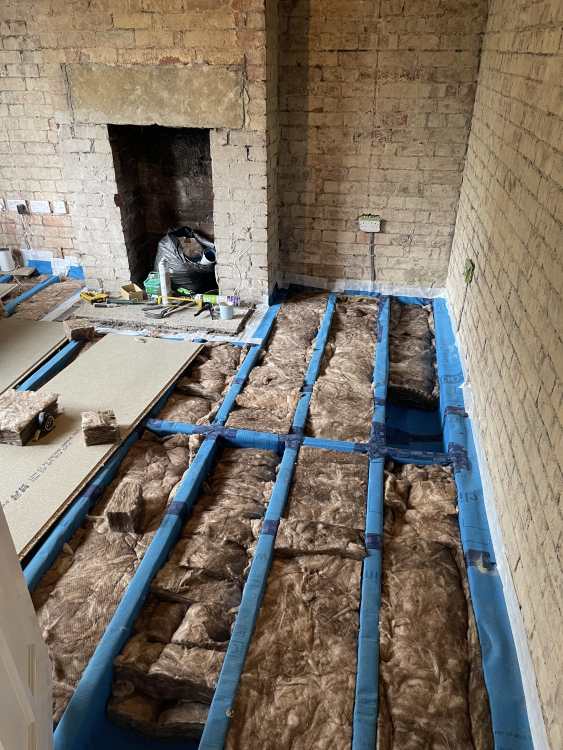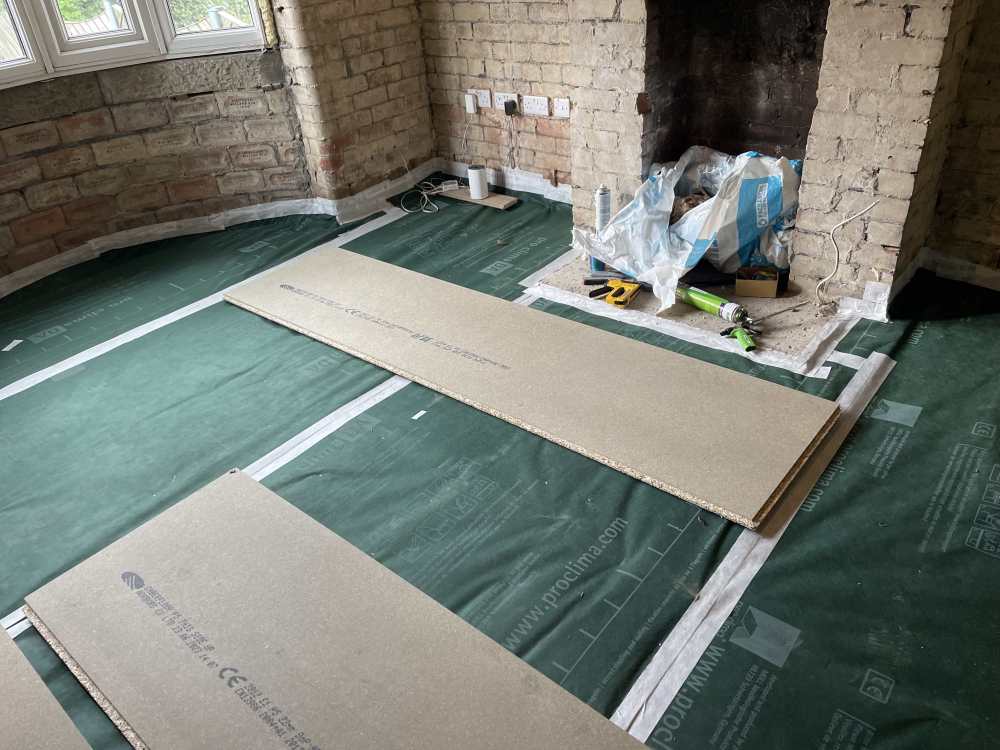
IGP
Members-
Posts
133 -
Joined
-
Last visited
-
Days Won
1
Everything posted by IGP
-
Best way is to not, and use anti freeze valves instead.
-
I use it occasionally to check prices on tracker. Seems legit so far.
-
Indeed, just to give another example is that my annual gas consumption is 10,750kWh /year. I know that during summer I use around 5kWh per day for hot water ~ 5*340 days (we go on holiday occasionally!) = 1,700 kWh. So 10750-1700=9,050 kWh of heating, accounting for efficiency of 90% (running at 40c flow temp) = 8145kWh/year. Dividing by the degree days of 2350 for my location for last year =3.46kW heat loss which isn’t far from my modelled heat loss in heat punk of 3.6kW at -3c outdoor. To be clear I kept my house at 20/21c all day and 19c at night all winter. So, if you can do a similar calculation @LeeVanCleef you’ll ball park your heat loss (assuming you adequately heated your home in the first place) without having to do anything fancy with air changes.
-
What's the case for not getting an ASHP?
IGP replied to kentar's topic in Air Source Heat Pumps (ASHP)
There is a kernel of truth there, as solutions like Havenwise wouldn’t exist. However, the fact that they do exist means that this tinkering as mentioned will be done automatically by services like Havenwise for the majority of people - giving them the benefits the people on these boards get from doing things manually now. So, I’d say that argument is going to be a moot point not long from now. -
And if you go onto something like Octopus Go you could be using 8p/kWh to do the DHW so COP becomes even less relevant.
-
Advice on bathroom heat strategy
IGP replied to SomethingSensible's topic in Air Source Heat Pumps (ASHP)
Why wouldn’t you just put UFH with the spacing for the required heat output for the room (or rads) on the ASHP open loop and have pure electric towel heaters just for warmed towels, timed for a few hours a day? -
Yes sounds like solar gain. Like a greenhouse. Do you have an ASHP?
-
Buffer Tank Hot when Heating Mode Turned Off
IGP replied to James1234's topic in Air Source Heat Pumps (ASHP)
I would suspect like a lot of heat pumps in that output range, they’re actually the same physical units but firmware limited top output. Would need to check the model numbers etc to confirm, but usually the dimensions and the refrigerant charge etc between the units would be identical. If that’s the case, then there would be no harm done whatsoever by putting the 9kW in. If I was in your position I would be reaching out to a suitably trained plumber (heat geek or equivalent) rather than Daikin Technical, just because the focus is on the system as a whole and all the bits that aren’t the ASHP itself whereas a Daikin guy might be focused on the ASHP itself rather the rest of the system (hence, from a manufacturer perspective - buffers are fantastic as the rest of the system is now hydraulically separated and definitely not their problem, irrespective of the issues they an cause) -
Buffer Tank Hot when Heating Mode Turned Off
IGP replied to James1234's topic in Air Source Heat Pumps (ASHP)
Looks like a buffer, the drawing suggests a volumiser but the photo looks like it has four ports being used. Looks like it could do with the buffer being removed (or at least bypassed with the aid of a bit of piping and valves). Also sounds like it’s over zoned and can see third party controls which generally mean weather compensation isn’t been used. Could be wrong but it looks like it’s been setup very boiler-esque. -
I haven’t got an ASHP yet (hopefully later in the year) but I’m planning for having cooling, but it will be have to be high wall fan coils (of which I can’t find many examples). My plan in my head is to run the chilled water pipes (insulated of course) through the loft, and drop them down through the ceiling within trunking for each bedroom, and have a condensate pump for each fan coil pushing the condensate back up into the loft and the condensate to join the existing MVHR condensate line there. Im thinking it will also need to be a separate zone as we don’t want chilled water going to the rads (it’s all rads). Has anyone else done something similar? Is this stupid? What about the water in the cooling zone for the heating season? Or should I forget it and go classic mini-split air conditioning?
-
Just a point on tax take, across the economy that’s true, I.e the highest it’s been for a long time - but also couldn’t be further from the truth when it comes to taxes on individuals on or around average incomes. https://ifs.org.uk/articles/how-tax-burden-high-when-most-us-are-taxed-so-low People hear “tax burden highest ever” and assume that includes them as it ‘feels’ like it is - but for most it’s just not actually true.
-
Which type of cavity fill is regarded as dependable?
IGP replied to Ubert's topic in Heat Insulation
Blown EPS beads for me. -
I would try to keep it as simple as possible, and without knowing the layout etc, if I was in your position I would personally; Go as big as you can without being daft on loft/roof insulation. It's cheap and simple. Fill the cavities where you have them with blown EPS beads. If you're going back to brick/stone anyway - perhaps the vapour open insulating plaster (diathonite?) would be sensible over slapping PIR over it and introducing interstitial condensation risk. Have MVHR - I would prioritize 24/7 air quality and humidty control over an occasional log burning from an non-room sealed log burner. Air-tightness generally is key as I'm sure you're aware. Foam and tape everywhere! Go ASHP, if you're having UFH anyway make sure they are 100mm centres for the lowest flow temperature possible and continuous heat. Don't worry too much about losing too much heat to the ground - earth is insulating (otherwise GSHP's with loops wouldn't work), and the priority should be designing the heating system to get the lowest flow temperature as possible get the efficiency gains here rather than spending *loads* on fancy insulation like VIPs (unless you have some *crazy* thermal bridges). Get a really good ASHP that runs v quiet, I'm going for a Viessmann Vitocal 151-A which seems to be super quiet, v efficient and also has an integral DHW cylinder. This may or may not fit the bill, but there are other options out there for sure. That's what i would do, as you can go as far as you like with insulation but it it becomes diminishing returns quickly and having an efficient ASHP setup can more than make up for imperfect insulation levels.
-
Kingspan Kooltherm K103 Floor K108 Cavity wall 0.019 W/mK
IGP replied to Caroline's topic in Heat Insulation
As other state earlier, don’t go PIR in cavity, all too easy to get wrong. Example thread. Full fill all the way be that mineral wool batts or blown EPS beads. -
Floor insulation with an old chimney breast
IGP replied to HighlyVolatile's topic in Heat Insulation
You could just PIR in this zone being careful to foam and tape to stop draughts coming up between the PIR and joists? The PIR is a better insulator than fibrous insulation, so you can go thinner for the same performance - keeping that air gap for those joists. Then just carry on as you were for the rest of the floor, that’s what I would do with the info you’ve provided so far. -
100% this. Example of PIR done badly is here
-
Wow, that’s er not good in the politest sense… I wonder if you could drill through the wall and through the PIR, and using a really long toggle to allow you pull the PIR to the inner leaf, working from the bottom up. Otherwise, given that the PIR is loose inside the cavity, I don’t suppose there is an option of removing it somehow, then once done, fill with blown EPS beads?
-
It didn’t make a difference to the air temperature as that set to a steady 20c, but the floor itself was like 12c prior to insulation and now is about 19c post. Can happily walk on the floor barefoot and not be cold at all. We’ve got about 180mm of mineral wool for the insulation layer. Definitely put a vapour membrane on the top and tape to wall, stops moisture from the room air condensing inside the insulation layer. Do it once, do it right.
-
I did the Ecological Building systems approach in my 30’s semi detached, and it’s made the world of difference. No draughts anywhere, and a warm floor in winter. Highly recommend.
-
I’d love to have gone Enerphit just for the warm fuzzy feeling of being in a highly insulated house. However, I just couldn’t make the sums work, and ended up focusing on airtightness, loft insulation, CWI, suspended floor insulation, MVHR. No major insulation work like IWI / EWI though. It’s a 1930’s semi detached. Then, I’ve done my heat loss, upgraded all the rads to run at 38c flow at -3c OAT and getting my energy use down further through high SCOP of my heat pump I’ll be installing later this year. So, I’ll be going from 18,000kWh+ gas/year pre-renovation to 10,000kWh now and then to around 2500kWh electricity (assuming all goes well with the HP as planned) for heating and DHW. But horses for courses and people do it differently 🙂
-
Don’t zone if at all possible. Adjust the spacing of the UFH loops to match the intended design temperature for particular rooms while running a single low flow temperature.
-
Insulating a pebbledashed bay. Risk of interstitial condensation?
IGP replied to Phillymclee's topic in Heat Insulation
I did something similar but used foil backed PIR, foamed and taped. Then put a vapour check membrane over that and taped that to the wall, floor and windows. So far so good, but I have MVHR now so that keeps the humidity low during the winter. -
I'm not so sure on electricity being a one-way bet, unless all you're thinking about its price cap/fixed tariffs. Taking Octopus agile as the most extreme example of the smart tariffs, it's clear that the average price is in the 15-18 p/kWh range if you can avoid lots of consumption between 4-7pm. Given that a HP would run low and slow all day, the vast majority would be at these averages (you could also do a setback during the 4-7pm peak). There are numerous other smart tariffs, each with their own pros and cons but they usually mean there are bargains to be had if you want to take them.
-
Which is why I’ve come to the conclusion that we probably should be only recommending 300mm loft insulation, CWI (if have cavities wide enough) and upgrading to DG from SG for *most* properties, unless you happen to be doing more work anyway and can insulate more while there. New builds should be much higher standards. These are the highest impact per £ invested. And then HPs at <45c design flow temp as that is around at the point where SCOP for most HPs beats the spark gap and saves money for people (and be therefore can be seen as better, not just equal to gas). But that’s just my rules of thumb.





